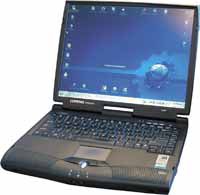In 1983, the Tandy Corporation released the TRS-80, one of the world’s first “portable” (i.e. “laptop”) computers which operated on double “AA” batteries. It was powered by an Intel 80c85 (3 MHz) processor and contained a whopping 8 kilobytes of RAM.
Today, laptop computers (often called a “notebook” computer) have undergone major change in design, size and capability and share very little with their early predecessors. Modern notebook computers are more powerful and capable than ever, and are becoming extremely popular. However, because notebooks can be fairly expensive, many want to know what their pros and cons are before they buy one.
All of a notebook’s benefits essentially boil down to convenience. They are highly portable, extremely light and take up very little space. They can be used almost anywhere, and most will run on batteries for a number of hours before a recharge is needed.
However, there are a number of disadvantages that must be considered:
• Easier to steal. Due to a notebook’s increased mobility, a thief can walk away with your notebook just as easily as you can.
• More prone to damage. Because they are extremely mobile, notebooks are inherently prone to physical abuse, especially during transport.
• More expensive. Notebook computers require extremely compact electronics to keep them light and easy to carry. As such, they are typically more expensive than their desktop counterparts. A 2 GHz notebook can easily cost 50% more than a desktop equivalent.
• Limited expansion and upgrade options. Today’s notebooks are extremely light-weight and highly compact. Many of the components inside are non-removable (like the network and video cards, for example), which can make some upgrades impossible. In addition, notebooks have little free space inside of them, which makes adding internal devices (like additional CD or DVD drives, hard drives, etc) very difficult.
• Difficult to acquire parts. Because internal parts are frequently non-removable and of little demand, most computer stores don’t carry notebook components, making it difficult to acquire parts. For example, suppose you want to upgrade your notebook’s hard drive with a higher-capacity one. Although most notebook hard drives are replaceable, many vendors don’t carry notebook hard drives and those that do rarely keep them in stock. Searching the Internet is often the only available route.
• Unequal performance. Traditionally, notebook computers have not performed quite as well as desktop computers with comparable specs, (for example, a 1 GHz notebook PC doesn’t perform as well as 1 GHz desktop PC). Because all of a notebook’s hardware is crammed into such a small compartment, it must be extremely heat efficient. Such hardware must also be power efficient to extend the life of each battery charge. As a result of these stipulations, a notebook’s performance often falls short of many desktop equivalents.
Notebook specs are similar to desktop systems, but differ slightly due to differences in cost. Keep in mind that notebooks aren’t as upgradeable as their desktop counterparts, so anticipating what performance or capability you may need in the future is very important. The following is a list of recommended specs for a new notebook:
• 1.5 GHz processor or higher. Most “mobile processors,” can scale their speed back when necessary to extend battery life.
• 256 MB of RAM. Like any other computer, the more memory, the better. Most modern notebooks have the capability to add RAM later, but it is easier to have plenty of RAM installed when you buy the notebook.
• 20 GB (gigabyte) hard drive. The more capacity, the better. 30 and 40 GB hard drives are becoming more and more common in new notebooks.
• Built-in network (LAN) card (it is difficult to buy a new notebook that doesn’t have a built-in LAN card).
• An ActiveMatrix or better LCD screen. More expensive screens will provide better on-screen color and contrast.
• Dual fans (if possible). Check the back of the notebook. Having at least two fans helps keep the computer ventilated.
Investing in an optical USB mouse is highly suggested. Every notebook has a built-in touch pad interface, but can be cumbersome to use for extended periods of time.
If you are thinking about buying a notebook for your primary computer, you may want to invest in a docking station and a compatible notebook. The docking station is typically left home, with printers, scanners and other non-mobile devices plugged into it. When the notebook attaches to the docking station, it is automatically attached to these additional devices. Without a docking station, printers, scanners and such must be constantly plugged in and unplugged as your notebook comes and goes.
Notebook computers are not for everyone, but for many they are a complete solution. A little forethought and some thorough research will help you make that decision.
Have comments or suggestions for a weekly Tech Tips article? Send an email to webmaster@sunad.com.
Buying a Laptop Computer

